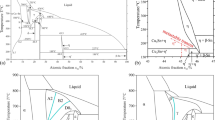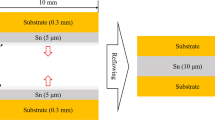Abstract
The main objective in exploring a lead-free solder system comprising Gallium, Indium, and Tin lies in the desire to mitigate health hazards related to lead exposure. This research aims to substitute hazardous lead-based solder with a safer alternative due to the non-toxic nature without compromising the other properties. In this study, we investigated the partial and integral enthalpy of mixing for Gallium–Indium (Ga–In), Gallium–Tin (Ga–Sn), and Indium–Tin (In–Sn) binary alloy systems by the help of drop calorimeter at different temperatures of 673 K, 723 K, and 773 K. The results demonstrate that the enthalpy of mixing exhibits certain variations with temperature and composition, providing insights into the interatomic interactions between the constituent elements in the alloy systems. Endothermic enthalpies of mixing were obtained for the Ga–Sn and Ga–In system but slightly exothermic nature was observed for In–Sn system. After getting enthalpy data from the experiments, a Redlich–Kister polynomial fitting was employed to accurately describe the binary interactions within each alloy system. The variation of enthalpy of mixing was found to be temperature dependent for the Ga–In and Ga–Sn system but temperature independency was observed in In–Sn system. Binary interaction parameters for the Ga–Sn, Ga–In and In–Sn were determined at different temperatures. It was observed that interaction parameters are temperature dependent for the Ga–In and Ga–Sn system and independent for the In–Sn system. Comparison of partial molar and integral molar enthalpies of mixing obtained from this study with the literature was attempted. It was found that the results obtained in this study show very good agreement with the data available in literature.









Similar content being viewed by others
Data availability
The authors state that the data supporting the study’s findings are included in the article. Additional relevant data that complement the study can be obtained from the corresponding author upon a reasonable request.
References
P.D. Sonawane, V.K. Bupesh Raja, K. Palanikumar, E. Ananda Kumar, N. Aditya, V. Rohit, Effects of gallium, phosphorus and nickel addition in lead-free solders: a review. Mater. Today Proc. 46, 3578–3581 (2020). https://doi.org/10.1016/j.matpr.2021.01.335
M.N. Ervina Efzan, M.N. Nur Faziera, Review on the effect of gallium in solder alloy. IOP Conf. Ser. Mater. Sci. Eng. (2020). https://doi.org/10.1088/1757-899X/957/1/012054
M.S. Yeh, Effects of indium on the mechanical properties of ternary Sn–In–Ag solders. Metall. Mater. Trans. A Phys. Metall. Mater. Sci. 34(2), 361–365 (2003). https://doi.org/10.1007/s11661-003-0337-0
I.G.B.B. Dharma, M. Hamdi, T. Ariga, The effects of adding silver and indium to lead-free solders. Weld. J. (Miami, FL) 88(4), 45–48 (2009)
K. Kanlayasiri, M. Mongkolwongrojn, T. Ariga, Influence of indium addition on characteristics of Sn–0.3Ag–0.7Cu solder alloy. J. Alloys Compd. 485(1–2), 225–230 (2009). https://doi.org/10.1016/j.jallcom.2009.06.020
C.K. Behera, A. Sonaye, Measurement of zinc activity in the ternary In–Zn–Sn alloys by EMF method. Thermochim. Acta 568, 196–203 (2013). https://doi.org/10.1016/j.tca.2013.06.039
M.R. Kumar, S. Mohan, C.K. Behera, Measurements of mixing enthalpy for a lead-free solder Bi–In–Sn system. J. Electron. Mater. 48(12), 8096–8106 (2019). https://doi.org/10.1007/s11664-019-07646-0
V. Singh, D. Jaiswal, D. Pathote, C.K. Behera, drop calorimetric measurement of In–Zn system for lead-free solder applications. Mater. Today Proc. 57, 285–288 (2022). https://doi.org/10.1016/j.matpr.2022.02.601
C.K. Behera, M. Shamsuddin, Thermodynamic investigations of Sn–Zn–Ga liquid solutions. Thermochim. Acta 487(1–2), 18–25 (2009). https://doi.org/10.1016/j.tca.2009.01.004
F.M. Azizan, H. Purwanto, M.Y. Mustafa, Effect of Sn addition on mechanical properties of zinc-based alloy. Adv. Mater. Res. 576, 378–381 (2012). https://doi.org/10.4028/www.scientific.net/AMR.576.378
A.V. Khvan et al., Thermodynamic properties of tin: part I, experimental investigation, ab-initio modelling of α-, β-phase and a thermodynamic description for pure metal in solid and liquid state from 0 K. Calphad Comput. Coupling Phase Diagrams Thermochem. 65, 50–72 (2019). https://doi.org/10.1016/j.calphad.2019.02.003
V. Singh, D. Pathote, D. Jaiswal, M.R. Kumar, K.K. Singh, C.K. Behera, Measurement of mixing enthalpies for Sn–Bi–Sb lead-free solder system. J. Electron. Mater. (2023). https://doi.org/10.1007/s11664-023-10579-4
M.R. Kumar, S. Mohan, C.K. Behera, Thermodynamic accessment experimentally on Bi–Sn System by calorimeter. Mater. Today Proc. 5(14), 27777–27785 (2018). https://doi.org/10.1016/j.matpr.2018.10.013
S.J. French, The: gallium–indium system. J. Phys. Chem. 1(5), 33–35 (1954)
J.P. Denny, J.H. Hamilton, J.R. Lewis, Constitution of the system gallium–indium. JOM 4(1), 39–42 (1952). https://doi.org/10.1007/bf03397646
W.J. Svirbely, S.M. Selis, The gallium–indium system. J. Phys. Chem. 58(1), 33–35 (1954)
I. Ansara, J.P. Bros, C. Girard, Thermodynamic analysis of the GaIn, AlGa, AlIn and the AlGaIn systems. Calphad 2(3), 187–196 (1978). https://doi.org/10.1016/0364-5916(78)90008-1
T.J. Anderson, I. Ansara, The Ga–In (gallium–indium) system. J. Phase Equilib. 12(1), 64–72 (1991). https://doi.org/10.1007/BF02663677
I. Ansara, M. Gambino, J.P. Bros, Étude Thermodynamique Du Système Ternaire Gallium–Indium–Antimoine. J. Cryst. Growth 32(1), 101–110 (1976). https://doi.org/10.1016/0022-0248(76)90016-6
D. Jendrzejczyk-Handzlik, P. Handzlik, Enthalpies of mixing of liquid Ga–In and Cu–Ga–In alloys. J. Mol. Liq. 293, 111543 (2019). https://doi.org/10.1016/j.molliq.2019.111543
D. Jendrzejczyk-Handzlik, P. Handzlik, Mixing enthalpies of liquid Au–Ga–In alloys. J. Mol. Liq. 301, 112439 (2020). https://doi.org/10.1016/j.molliq.2019.112439
B. Predel, D.W. Stein, Thermodynamic properties of the gallium–indium systems. J. Less Common Met. 18(1), 49–57 (1969)
T.J. Anderson, I. Ansara, The Ga–Sn (gallium–tin) system. J. Phase Equilib. 13(2), 181–189 (1992)
I. Ansara, J.P. Bros, M. Gambino, Thermodynamic analysis of the germanium-based ternary systems. Angew. Chem. Int. Ed. 3(3), 225–233 (1979)
D. Li, S. Delsante, W. Gong, G. Borzone, Partial and integral enthalpies of mixing of Ag–Ga–Sn liquid alloys. Thermochim. Acta 523(1–2), 51–62 (2011). https://doi.org/10.1016/j.tca.2011.04.032
M. Fornaris, Y.M. Muggianu, M. Gambino, J.P. Bros, Enthalpy of formation of gallium–germanium–tin liquid alloys: evaluation of the liquidus surface of the phase diagram from excess functions of mixing. Z. Nat. Sect. A J. Phys. Sci. 35(11), 1256–1264 (1980). https://doi.org/10.1515/zna-1980-1121
I. Katayama, K. Maki, M. Nakano, T. Iida, Thermodynamic activity in liquid Ga–Sn alloys studied by EMF method. Mater. Trans. JIM 37(5), 988–990 (1996)
S. Kulawik, W. Gierlotka, A. Dębski, W. Gąsior, A. Zajączkowski, Thermodynamic assessment of the Ga–Sn–Zn system. Calphad Comput. Coupling Phase Diagrams Thermochem. (2020). https://doi.org/10.1016/j.calphad.2020.101765
D. Živković, D. Manasijević, Z. Živković, Thermodynamic study of Ga–Sn and Ga–Zn systems using quantitative differential thermal analysis. J. Therm. Anal. Calorim. 74(1), 85–96 (2003). https://doi.org/10.1023/A:1026373602352
M. Rechchach, A. Sabbar, H. Flandorfer, H. Ipser, Enthalpies of mixing of liquid In–Sn and In–Sn–Zn alloys. Thermochim. Acta 502(1–2), 66–72 (2010). https://doi.org/10.1016/j.tca.2010.02.008
T.M. Korhonen, J.K. Kivilahti, Thermodynamics of the Sn–In–Ag solder system. J. Electron. Mater. 27(3), 149–158 (1998). https://doi.org/10.1007/s11664-998-0205-1
B.J. Lee, C.S. Oh, J.H. Shim, Thermodynamic assessments of the Sn–In and Sn–Bi binary systems. J. Electron. Mater. 25, 983 (1996)
C. Luef, H. Flandorfer, H. Ipser, Enthalpies of mixing of liquid alloys in the In–Pd–Sn system and the limiting binary systems. Thermochim. Acta 417(1), 47–57 (2004). https://doi.org/10.1016/j.tca.2004.01.019
D. Živković, A. Mitovski, L. Balanović, D. Manasijević, Ž Živković, Thermodynamic analysis of liquid In–Sn alloys using Oelsen calorimetry. J. Therm. Anal. Calorim. 102(3), 827–830 (2010). https://doi.org/10.1007/s10973-010-0785-x
R. Hultgrcn, R.L. Orr, P.D. Anderson, K.K. Kelley, Selected Values of Thermodynamic Properties of Metals and Alloys (Wiley, New York, 1963)
I. Ansara, N. Dupin, Cost 507 Thermo Chemical Database for Light Metal Alloys (European Commission DG X11, European Commission, Luxembourg, 1998)
V. Singh, D. Jaiswal, D. Pathote, K. K. Singh, C.K. Behera, Measurement of mixing enthalpies for Bi-Zn lead-free solder system. Mater Today Proc. (2023). ISSN 2214-7853. https://doi.org/10.1016/j.matpr.2023.08.004
D. Jaiswal, D. Pathote, V. Singh, C.K. Behera, Electrochemical behaviour of lead-free Sn–In–Al solders alloys in 3.5 wt. % NaCl solution. Mater Today Proc. (2022). https://doi.org/10.1016/j.matpr.2022.02.315
D. Jaiswal, V. Singh, D. Pathote, C.K Behera, Electrochemical behavior of lead-free Sn–0.7Cu–xIn solders alloys in 3.5 wt% NaCl solution. J Mater Sci Mater Electron. 32(18), 23371–23384 (2021). https://doi.org/10.1007/s10854-021-06824-03
M.R. Kumar, V. Singh, V.K. Rai, D. Jaiswal, C.K. Behera, Investigation on mixing heat effect of bi-in and in-sn system at 730 K. Mater. Today Proc. 18, 2917–2923 (2019). https://doi.org/10.1016/j.matpr.2019.07.161
D. Jaiswal, D. Pathote, V. Singh, C.K Beher, Effect of Al addition on electrochemical behavior of Sn-0.7Cu-xAl lead-free solders alloys in 3.5 wt. % NaCl solution. J Mater Eng Perform. (2022). https://doi.org/10.1007/s11665-022-06771-y
V.K. Rai, M.R. Kumar, V. Singh, D. Jaiswal, C.K. Behera, Analysis of corrosion behavior and its characterization of in-sn-bi alloy. Mater. Today Proc. 18, 2322–2328 (2019). https://doi.org/10.1016/j.matpr.2019.07.015
Acknowledgements
The authors would like to express their gratitude to the Head of the Department of Metallurgical Engineering, Indian Institute of Technology (Banaras Hindu University), Varanasi, India, for giving the assistance necessary to carry out the current study.
Funding
There is no funding to declare.
Author information
Authors and Affiliations
Contributions
VS—Conceptualization, methodology, formal analysis, writing of the original draft. DP and DJ—Visualization. KKS and CKB—supervision and writing of the original draft.
Corresponding author
Ethics declarations
Conflict of interest
There are no conflict of interest, according to the authors.
Additional information
Publisher's Note
Springer Nature remains neutral with regard to jurisdictional claims in published maps and institutional affiliations.
Rights and permissions
Springer Nature or its licensor (e.g. a society or other partner) holds exclusive rights to this article under a publishing agreement with the author(s) or other rightsholder(s); author self-archiving of the accepted manuscript version of this article is solely governed by the terms of such publishing agreement and applicable law.
About this article
Cite this article
Singh, V., Pathote, D., Jaiswal, D. et al. Calorimetric measurements of Ga–In, Ga–Sn, and In–Sn binary alloy systems as sustainable lead-free solder alternatives. J Mater Sci: Mater Electron 34, 2089 (2023). https://doi.org/10.1007/s10854-023-11521-4
Received:
Accepted:
Published:
DOI: https://doi.org/10.1007/s10854-023-11521-4




